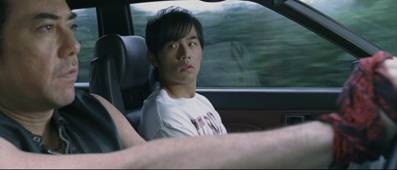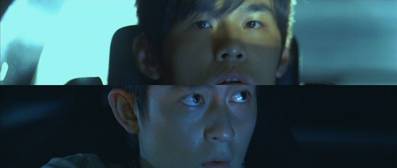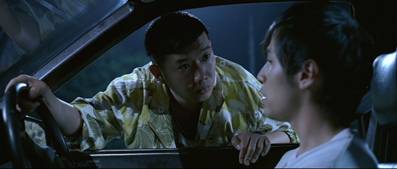|
As
Initial D: Drift Racer opens and the English/Chinese
opening credits appear over circling aerial shots of twisted
mountain roads and twangy techno fills the soundtrack (more
on that later), I was reminded of something, I just couldn't
pinpoint what. It was the next day when I ran the same sequence
on a computer monitor at work that the answer came from
a colleague. "What's that?" he asked
as he passed, "A new Grand Turismo game?"
Funny you should say that...
Drift
racing appears to be one of media import flavours of the
moment, being central to both this film and the US production
The Fast and the Furious 3: Tokyo Drift
and even making an appearance in the upcoming Pixar animation
Cars. For those not in the know, drift
racing – or drifting as it is more commonly known – is a
technique in motor sport in which corners are taken in what
is essentially a controlled skid or power slide, much like
the motorcycles in speedway riding. It first came to serious
prominence in Japan in the early 1970s, when it became the
trademark technique of motorbike rider turned car racer
Kunimitsu Takahashi, but its present cult status relates
more to the illegal drift races held at night on mountain
roads in Nagano, Hakone and Irohazaka by young Japanese
boy racers. It was from this that the hugely successful
Initial D manga comics sprang, and it is on these that Initial
D the movie is based.

There's
a good chance that a few of you have already painted a brain
picture of what a manga-inspired Hong Kong actioner based around
drift racing will look and play like, and although I'm not
one for pre-judging any film, I'd have to say that, to a
certain degree at least, you're probably right. The characters are
all familiar generic creations with little depth, and their
narrative paths are laid clearly out for the audience to
easily predict. Our leading man is Takumi (Jay Chou), whose
father Bunta (Anthony Wong) runs a tofu shop by day and
gets plastered every night. Takumi spends his days working at a garage
owned by Yuuichi, whose son Itsuki is Takumi's best friend
and fancies himself as a street racer, but his attempt to
prove himself on the winding roads of Mount Akina where
the street racers meet marks him as a clear no-hoper. Takumi,
on the other hand, has been delivering tofu at night on
this route for some time and has developed
a natural talent for fast driving and drifting around corners,
and is soon challenged both by the super-cool Ryousuke and
overly cocky team racer Kyouchi. Now how do you reckon this
plays out? Takumi's underdog status is enhanced by his older,
less powerful car, which of course breaks down at a key
stage in the story. But wait a minute, his drunken father
was once a champion driver himself, and if he can just pull
himself together...
OK,
complaining that the plot and characters are by the numbers
in a film like Initial D might seem to
be missing the point – after all, I've put up with some
woefully trite nonsense to sit ringside at a good kung-fu
fight, and if watching cars hurtle sideways round hairpin
bends floats your boat then you won't care two hoots about
the shortcuts taken elsewhere. Certainly it's the driving
that's the pull here, and impressive it is, thanks in no
small part to an abandonment of the CGI of Hollywood actioners
(save for a couple of shots in which
the camera flies through car windows and into engines) in
favour of letting a team of real drift racers show off their
considerable handling skills. True to its title, the drift races
are the film's raison d'être, with other
plot points – including Takumi's romance with innocent-looking
Natsuki, a sub-story that has one of the film's few unexpected
twists – dealt with hurriedly and having a tacked-on feel.

Spiffy
though the driving sequences are, the edge is occasionally
taken off them by superficially flashy camera and
editing tricks, which recognises both the comic book origins
and the MTV attention span of its target audience. Fortunately,
this is kept to minimum in the races themselves, which are
inventively shot and briskly edited, to the extent that
cut-aways to onlookers or other interested parties trigger
an instant desire to get the hell back to the race. The
emphasis here is as much on technique as speed, with the
sometimes exciting bolted-to-car and roadside shots intercut
close-ups of gear changes and and an intriguing pedal action
that involves tapping the brake and accelerator at the same
time.
Despite
the shallow elements, it proves intermittently engaging
stuff. The slight oddness of having Japanese characters
played by Chinese actors and speaking (post-dubbed) Cantonese
is offset by an otherwise authentically Japanese feel to
the characters and settings (OK, it was filmed in Japan,
but you know what I mean). Jay Chou's Takumi in particular
makes for an enjoyably unassuming lead – reluctantly competitive
and seemingly half asleep when he drives, he barely even
acknowledges a race win, which proves a refreshing change from the triumphant
whooping and steering wheel hammering you'd probably find in its US equivalent.
And despite a few minor gripes about the handling of the
action and the predictability of the character and narrative
arcs, I still found myself secretly rooting for Takumi each
time he sat behind the wheel.
In every other respect the film delivers on expectations
both high and low – it's niftily paced, slickly presented
and the races themselves are tastily executed, but it's
also largely predictable and ultimately insubstantial. If
you're coming to the film for the cars and the driving then
there's plenty here to hold your interest, but those looking
for a film with the character and plot depth of the directors'
previous Infernal Affairs trilogy may be
in for a bit of a let down.
I
mention this separately because there are two music tracks
included, the Chinese original and a new score commissioned
specifically for the UK market, written by Nicholas Zart
for Fuel. Now views will differ on this process of rescoring
films for different markets, but frankly I find the whole
process annoying, both in its condescending reading of the
potential UK audience (the belief that they won't watch
a film about racing if the music is too 'Eastern') and the
very idea that someone not involved in the original production
thinks they know more than the director(s) about how their
film should sound. This decision appears to be spring from
a belief that the potential UK audience will not be the
traditional Hong Kong action cinema fans, for whom the original
score would meet with generic expectations, but Men
and Motors regulars and computer game racing wannabes
who are just going to buy the film for the driving scenes
alone, and for whom the original score would be, well....well,
WHAT exactly?

Listening
to both scores, I cannot see what the issue was with the original
– sure, there are some cheesy musical moments, especially
during scenes involving Takumi and Natsuki, but at least
the music is halfway appropriate, unlike the electronic
tinkling of the Fuel replacement. Certainly for those familiar
with Hong Kong action cinema, the original score will seem
fine, incorporating as it does a wide range of source tunes, from bass-driven
hip-hip to the slushily romantic to some rather nifty mixing
of guitar, electronic and traditional instruments. The Fuel
track, on the other hand, is a more generic blend of electronic
whines and techno pulses, and at times plays more like the
soundtrack to a video game than a film, hence my colleague's
comment at the top of the review. Both soundtracks contain sequences where
there is music on one track and silence on the other, and
there are times when the new track completely changes the
feel and even emotional thrust of scenes. For my money the
original track is infinitely preferable – the Fuel music,
although quite neat in places, is too often inappropriate
for the on-screen action, and soon gets both repetitive
and a little irritating. In the end, if you're watching
the film with the new track you are not seeing the version
that Lau and Mak made.
I
do, however, salute Premiere Asia for including both scores,
and still feel the failure to include the original music
track was a serious flaw with the otherwise excellent Ong-Bak
DVD.
Contender
have built solid reputation for fine transfers on their
Premiere Asia and Hong Kong Legends labels, and Initial
D: Drift Racer does not let the side down. Colour
and contrast are very good, the print is spotless and the
detail is crisp without obvious edge enhancement. The biggest
challenge for the transfer is the night footage, of which
there is a lot – blacks are solid here, but there is a lot
of background lighting that leads to misty areas of similar
colour, and compression artefacts do make themselves visible
from time to time, but not intrusively. On the whole, a
very nice job. The framing is 2.35:1 and the picture is
anamorphically enhanced.

Three
soundtracks are available, with the original score in 5.1
only and the rescored version in 5.1 or DTS. The DTS track
is definitely superior, with music and sound effects reproduced
more crisply and with slightly better dynamic range. The
5.1 tracks are no slouch, though, with some very good separation
and rear speaker work, as well as some thumping good lower
frequencies on the music. Strangely, the original track
seems to have the edge on the 5.1 rescore.
Initial
D is being released as a 2-disc special edition, and while
most of the extra features are on disc 2, there is a notable
one on the first disc, a feature whose inclusion, unfortunately,
says a lot more about the perceived UK target audience than
it does about the film or its production. What we have here
is a commentary, not by the filmmakers
or the conspicuously absent Bey Logan, but Richie Warren
of Fuel and Darren Joyce of Dirty Sanchez, the
crap British version of the American idiot show Jackass.
I'm normally a huge fan of commentary tracks, for the background
information they can provide on the production or even the
facts behind the on-screen action, but listening to two
mouthy wide boys make dopey comments about the characters
and the action, point out the bleeding obvious, order a
tofu takeaway, make phone calls to their mates (one of whom,
it has to be said, supplies the only useful information
on the whole track), and laugh raucously at every single
fucking thing they say was the hardest work I've had to
do all week. The whole thing really nosedives with stupid
impersonations of Japanese modes of speech and the sort
of "ching-chang-chong" Chinese mockery that has
been used by both Father Ted and The
Simpsons to effectively brand characters as ignorant
racists.
Things
pick up a bit on disc 2, where the features are split into
four categories.
Promotional Gallery sports three trailers,
kicking off with a UK Theatrical Trailer
(1:39), which REALLY sells the film as a live-action Grand
Turismo, with Trailer Voice Man replaced by an East
End twang, another attempt to target a boy racer demographic.
The oxymoronic UK Theatrical TV Spot
(0:22) is a shorter version of the same. The Original
Theatrical Trailer (2:05) makes a connection
with the original manga comics through the graphical presentation
of the cast, but is otherwise a montage of fast driving
shots.
The
Interview Gallery will keep
you busy for some time, containing as it does three pages
of interviews with cast and crew members, the participants
are:
- Jay
Chou (6:42) – sleepy natural racer, Takumi;
- Anthony
Wong (5:16) – Takumi's alcoholic dad, Bunta;
- Shawn
Yue (6:18) – Takumi's initial rival, Takeshi
Nakazato;
- Kenny
Bee (6:06) – garage owner, Yuuichi Tachibana;
- Andrew
Lau (19:55) – soft-spoken producer and co-director;
- Alan
Mak (21:46) – lively co-director;
- Felix
Chong (16:11) – screenwriter;
- Anne
Suzuki (7:17) Natsuki, Takumi's girlfriend
with a secret;
- Edison
Chen (10:34) – super-cool street racer,
Ryousuke Takahashi;
- Jordan
Chan (7:23) cocky, bandana-wearing team
racer, Kyouichi Sudou
- Chapman
To (7:31) – Takumi's best friend and hopeless
wannabe racer, Itsuki Tachibana
Similar ground is covered in each of the cast interviews
– the attraction of the project, the comics, their own characters,
working with the cast and directors, playing Japanese and
the appeal of drift racing, with a few personal experiences
of the filming thrown in. All are conducted in Cantonese
with English subtitles, the exceptions being Kenny Bee,
whose English is fluent, and Suzuki, who is actually Japanese.
Co-director Lau covers the problems of clearing the copyright
on the original manga comics, which he describes as "a
Japanese national treasure," and the process of adapting
them for film and working with the cast, while colleague
Mak talks about the more technical aspects of the filming
and the racing. Chong, who looks as if the character of
Itsuki is based on him, covers the process of adapting the
original manga for film and the appeal of drifting to the
young.
Under
the Hood has 2 entries. Making
Initial D: Drift Racer (20:02) is a typical
Hong Kong making-of featurette – set to music, furiously
busy and covering a lot of ground, with plenty of interviews
(some of which have been incorporated from the above section)
and behind-the-scenes material, including some driving rehearsals.
Press Conference (7:43) is exactly
what it claims to be, and is in Chinese (except Anne Suzuki)
and subtitled.
Finally
we have Fuelled Up, a pointless
section featuring Maximum Bass 2 TV Spot
(0:41), a godawful TV commercial for the CD of the title,
targeted squarely at the FHM crowd, and Drift
Kings (7:00), an unstructured bit of home
video footage in which the pair responsible for that commentary
attend a drift racing meet, do a bit of driving and laugh
at loudly everything they do and say.
Not
really my cup of sake, but those who like their cars to
skid when they take corners will find enough here to keep
them happy, and the film does score points for using real
drivers rather than the computer generated mayhem of the
Hollywood equivalent. The 2-disc set from Premiere Asia
showcases the film well, with a strong transfer and a few
interesting extra features on disc 2, as well as an endurance
test on disc 1 for those hardy souls who made it through
Funny Games intact.
|